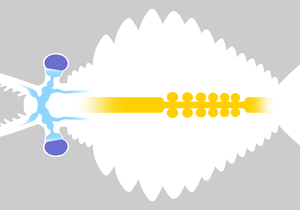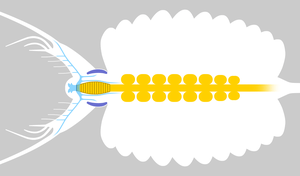Dinocaridida
Dinocaridida[derivation 1] is a proposed taxon[1] of extinct fossil arthropod-like marine animals found, with one exception, in the Cambrian and Ordovician.[2] The name of Dinocaridids comes from Greek, "deinos" and "caris", meaning "terror shrimp" or "terror crab", due to their crustacean-like appearance and the hypotheses suggesting that members of this class were amongst the dominating and most diverse apex predators of their time.[3] Dinocaridids occasionally referred as 'AOPK group' by some literatures, as the group compose of Radiodonta (Anomalocaris and relatives), Opabinia, Pambdelurion and Kerygmachela.[4] It is probably paraphyletic, with Kerygmachela and Pambdelurion more basal than the Opabinia and Radiodonta clade.
| Dinocaridida | |
|---|---|
 | |
| Assembles of Radiodonta | |
 | |
| Opabinia, Pambdelurion and Kerygmachela | |
| Scientific classification | |
| Kingdom: | Animalia |
| Phylum: | Arthropoda |
| Class: | †Dinocaridida Collins, 1996 |
| Subgroups | |
| |
| Part of a series on |
| The Cambrian explosion |
|---|
 |
|
Fossil localities |
|
Evolutionary concepts |
Anatomy


Dinocaridids were bilaterally symmetrical, with a mostly non-mineralized cuticle and a body divided into two major groupings of tagmata (body-sections): head and trunk. The head comprised only one segment (ocular somite)[5][6] and had two specialized frontal appendages just in front of the mouth and eyes. The frontal appendages are either lobopodous (in gilled lobopodians) or arthropodized (in Radiodonta) and usually paired, but highly fused into a nozzle-like structure in Opabinia.[7] Based on their preocular position and protocerebral origin, the frontal appendages are most likely homologous to the labrum of euarthropods and primary antennae of onychophora.[8][6] The trunk possessed multiple segments, each with its own gill branch and swimming flaps (lobes).[9] It is thought that these flaps moved in an up-and-down motion, in order to propel the animal forward[10] in a fashion similar to the cuttlefish. In gilled lobopodian genera, the trunk may have borne a lobopodous limb (lobopod) underneath each of the flaps.[9] The midgut of dinocaridids had paired digestive glands similar to those of siberiid lobopodians and cambrian euarthropods.[11] Based on the neuroanatomical evidence from Kerygmachela and Lyrarapax, the dinocaridid brain comprised only a protocerebrum, with frontal appendage nerves and optic nerves connected to its anterior and lateral region respectively.[8][12]
Classification
|
Dinocaridida |
Although some authors may rather suggest a different taxonomic affinities (e.g. as cycloneuralian relatives[13][7]), most of the phylogenetic studies suggest that dinocaridids are stem group arthropods.[14][15][16][17][9][5][6][18][19][20] Under this scenario, Dinocaridida is a paraphyletic grade in correspond to the arthropod crown group (Euarthropoda or Deuteropoda) and also suggest a lobopodian origin of the arthropod lineage.[21][5] In general, the gilled lobopodian genera Pambdelurion and Kerygmachela which have lobopodian traits (e.g. lobopodous appendage, annulation) occupied the basal position; while Opabinia and Radiodonta are more derived and closely related to the arthropod crown group, with the latter even have significant arthropod affinities such as arthropodization and head sclerites.[20][22][5]
Only one order, Radiodonta, had been founded for Dinocaridida. Traditionally, Radiodonta included all dinocaridid taxa and all radiodonts were grouped under a single family: Anomalocarididae (hence the previous common name 'Anomalocaridids'[14]). In later studies, Opabinia, Pambdelurion and Kerygmachela were excluded from Radiodonta, and many radiodonts were reassigned to other new families (Amplectobeluidae, Tamisiocarididae and Hurdiidae).[17]
Distribution
The group was geographically widespread, and has been reported from Cambrian strata in Canada, China and Russia,[23] as well as the Ordovician of Morocco and Devonian of Germany.[24]
Notes
- Greek, "Terrible crabs" – sometimes informally spelt Dinocarida, but the second 'id' is linguistically correct – see Hou, Xianguang; Bergström, Jan; Jie, Yang (2006). "Distinguishing anomalocaridids from arthropods and priapulids". Geological Journal. 41 (3–4): 259–269. doi:10.1002/gj.1050.
References
- Collins, D. (1996). "The "Evolution" of Anomalocaris and Its Classification in the Arthropod Class Dinocarida (nov.) and Order Radiodonta (nov.)". Journal of Paleontology. 70 (2): 280–293. JSTOR 1306391.
- Van Roy, P.; Briggs, D. E. G. (2011). "A giant Ordovician anomalocaridid". Nature 473 (7348): 510–513. doi:10.1038/nature09920. edit
- Earth’s First Diverse Marine Predators Produced Killer Babies
- Liu, Jianni (2004). "A rare lobopod with well-preserved eyes from Chengjiang Lagerstätte and its implications for origin of arthropods". Chinese Science Bulletin. 49 (10): 1063. Bibcode:2004ChSBu..49.1063L. doi:10.1360/04wd0052. ISSN 1001-6538.
- Ortega‐Hernández, Javier (2016). "Making sense of 'lower' and 'upper' stem-group Euarthropoda, with comments on the strict use of the name Arthropoda von Siebold, 1848". Biological Reviews. 91 (1): 255–273. doi:10.1111/brv.12168. ISSN 1469-185X. PMID 25528950.
- Ortega-Hernández, Javier; Janssen, Ralf; Budd, Graham E. (2017-05-01). "Origin and evolution of the panarthropod head – A palaeobiological and developmental perspective". Arthropod Structure & Development. Evolution of Segmentation. 46 (3): 354–379. doi:10.1016/j.asd.2016.10.011. ISSN 1467-8039. PMID 27989966.
- Xianguang, Hou; Jan, Jan Bergström; Jiayu, In Rong; Zongjie, Fang; Zhanghe, Zhou; Renbin, Zhan; Xiangdong, Wang; Xunlai (eds, Yuan; Xianguang, Hou (2006). Dinocaridids – anomalous arthropods or arthropod-like worms?. CiteSeerX 10.1.1.693.5869.CS1 maint: extra text: authors list (link)
- Cong, Peiyun; Ma, Xiaoya; Hou, Xianguang; Edgecombe, Gregory D.; Strausfeld, Nicholas J. (2014). "Brain structure resolves the segmental affinity of anomalocaridid appendages". Nature. 513 (7519): 538–542. Bibcode:2014Natur.513..538C. doi:10.1038/nature13486. ISSN 0028-0836. PMID 25043032.
- Van Roy, Peter; Daley, Allison C.; Briggs, Derek E. G. (2015). "Anomalocaridid trunk limb homology revealed by a giant filter-feeder with paired flaps". Nature. 522 (7554): 77–80. Bibcode:2015Natur.522...77V. doi:10.1038/nature14256. ISSN 1476-4687. PMID 25762145.
- Usami, Y. (2006). "Theoretical study on the body form and swimming pattern of Anomalocaris based on hydrodynamic simulation". Journal of Theoretical Biology. 238 (1): 11–17. doi:10.1016/j.jtbi.2005.05.008. PMID 16002096.
- Vannier, Jean; Liu, Jianni; Lerosey-Aubril, Rudy; Vinther, Jakob; Daley, Allison C. (2014-05-02). "Sophisticated digestive systems in early arthropods". Nature Communications. 5 (1): 3641. Bibcode:2014NatCo...5.3641V. doi:10.1038/ncomms4641. ISSN 2041-1723. PMID 24785191.
- Park, Tae-Yoon S.; Kihm, Ji-Hoon; Woo, Jusun; Park, Changkun; Lee, Won Young; Smith, M. Paul; Harper, David A. T.; Young, Fletcher; Nielsen, Arne T.; Vinther, Jakob (2018-03-09). "Brain and eyes of Kerygmachela reveal protocerebral ancestry of the panarthropod head". Nature Communications. 9 (1): 1019. Bibcode:2018NatCo...9.1019P. doi:10.1038/s41467-018-03464-w. ISSN 2041-1723. PMID 29523785.
- Xian‐Guang, Hou; Bergström, Jan; Ahlberg, Per (1995-09-01). "Anomalocaris and other large animals in the lower Cambrian Chengjiang fauna of southwest China". GFF. 117 (3): 163–183. doi:10.1080/11035899509546213. ISSN 1103-5897.
- Daley, A. C.; Budd, G. E.; Caron, J.-B.; Edgecombe, G. D.; Collins, D. (2009-03-20). "The Burgess Shale Anomalocaridid Hurdia and Its Significance for Early Euarthropod Evolution". Science. 323 (5921): 1597–1600. Bibcode:2009Sci...323.1597D. doi:10.1126/science.1169514. ISSN 0036-8075. PMID 19299617.
- Edgecombe, Gregory D. (2010). "Arthropod phylogeny: an overview from the perspectives of morphology, molecular data and the fossil record". Arthropod Structure & Development. 39 (2–3): 74–87. doi:10.1016/j.asd.2009.10.002. ISSN 1873-5495. PMID 19854297.
- Legg, David A.; Sutton, Mark D.; Edgecombe, Gregory D. (2013). "Arthropod fossil data increase congruence of morphological and molecular phylogenies". Nature Communications. 4 (1): 2485. Bibcode:2013NatCo...4.2485L. doi:10.1038/ncomms3485. ISSN 2041-1723. PMID 24077329.
- Vinther, Jakob; Stein, Martin; Longrich, Nicholas R.; Harper, David A. T. (2014). "A suspension-feeding anomalocarid from the Early Cambrian". Nature. 507 (7493): 496–499. Bibcode:2014Natur.507..496V. doi:10.1038/nature13010. ISSN 1476-4687. PMID 24670770.
- Lerosey-Aubril, Rudy; Pates, Stephen (2018-09-14). "New suspension-feeding radiodont suggests evolution of microplanktivory in Cambrian macronekton". Nature Communications. 9 (1): 3774. Bibcode:2018NatCo...9.3774L. doi:10.1038/s41467-018-06229-7. ISSN 2041-1723. PMID 30218075.
- Moysiuk, J.; Caron, J.-B. (2019-08-14). "A new hurdiid radiodont from the Burgess Shale evinces the exploitation of Cambrian infaunal food sources". Proceedings of the Royal Society B: Biological Sciences. 286 (1908): 20191079. doi:10.1098/rspb.2019.1079. PMC 6710600. PMID 31362637.
- Chipman, Ariel D.; Edgecombe, Gregory D. (2019-10-09). "Developing an integrated understanding of the evolution of arthropod segmentation using fossils and evo-devo". Proceedings of the Royal Society B: Biological Sciences. 286 (1912): 20191881. doi:10.1098/rspb.2019.1881. PMC 6790758. PMID 31575373.
- Budd, G. E. (1996). "The morphology of Opabinia regalis and the reconstruction of the arthropod stem-group". Lethaia. 29: 1–14. doi:10.1111/j.1502-3931.1996.tb01831.x.
- Ortega-Hernández, Javier (2015-06-15). "Homology of Head Sclerites in Burgess Shale Euarthropods". Current Biology. 25 (12): 1625–1631. doi:10.1016/j.cub.2015.04.034. ISSN 0960-9822. PMID 25959966.
- Ponomarenko, A. G. (2010). "First record of Dinocarida from Russia". Paleontological Journal. 44 (5): 503–504. doi:10.1134/S0031030110050047.
- Kühl, G.; Briggs, D. E. G.; Rust, J. (Feb 2009). "A Great-Appendage Arthropod with a Radial Mouth from the Lower Devonian Hunsrück Slate, Germany". Science. 323 (5915): 771–3. Bibcode:2009Sci...323..771K. doi:10.1126/science.1166586. ISSN 0036-8075. PMID 19197061.
| Wikispecies has information related to Dinocaridida |